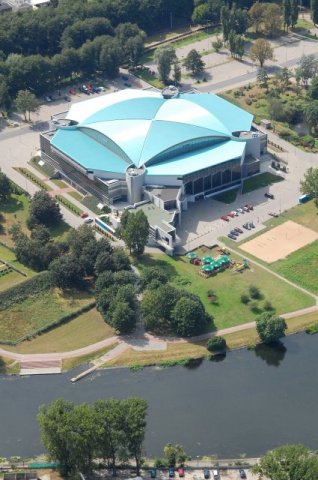Alarm systems
Alarms, cameras, monitoring in large industrial facilities, public and administrative and office facilities
Large buildings require appropriate, precisely tailored to the specificity of a building and complex of building security system. The security systems of industrial facilities, public facilities and administration and office facilities include alarm systems ensuring full security of the company. Modern alarm installations detect, alert and prevent the effects of spreading fires, protect property, identify thieves, and are also able to detect thefts and employee abuse. Currently, advanced alarm systems are becoming more and more popular in such cities as we operate as: Bydgoszcz, Toruń, Gdańsk, Gdynia and Poznań.
Along with the technological development of security systems, enterprises gain an effective tool for comprehensive and multi-level control of the company's environment. Alarm systems managed by means of a local network or with the use of wireless devices creating a wireless alarm are now becoming more and more popular, which ensures a significant saving of resources and time during their assembly and configuration.
Due to declining prices and growing availability of advanced alarm systems, companies are increasingly willing to implement them in their own facilities.
Classification of alarm installations
Regardless of the type of alarms, the overriding purpose of alarm systems is monitoring and signaling dangers related to incorrect conditions prevailing in the area of the facility.
Alarm installations can be categorized according to several criteria. The most important of them is the division of alarm installations according to the detected threats. According to this criterion, we divide alarms into:
- Closed Circuit Television system (CCTV);
- Burglary and Assault Signaling System, and Intrusion Detection System;
- Fire Alarm System;
- Peripheral Protection System (detection, signaling and communication).
In addition, the Intrusion Detection System is classified according to zone security on:
- 1st zone (peripheral protection) - provides external protection along the object's fence;
- II zone (external protection) - provides external protection in the vicinity of the facility, is implemented by means of: anti-burglary windows, grates, walls or other barriers and obstacles;
- III zone (internal protection) - provides internal protection of the facility, securing all door and window openings.
The alarm systems are also divided into the degree of security of the object against the intruder:
- Class I (low risk) - the intruder will not detect the alarm system;
- Class II (small - medium risk) - the intruder will have basic devices and instruments for the violation of property;
- Class III (medium - high risk) - the intruder knows the alarm systems well and possesses advanced devices - also electronic - that may affect the safety of the facility;
- Class IV (high risk) - the intruder knows the alarm system very well and is very well prepared for the robbery.
The last important division is the categorization of security elements in alarm systems according to their effectiveness:
- Class A (popular) - devices must have electromagnetic immunity;
- Class B (standard) - devices must have electromagnetic immunity, tamper protection and can not be neutralized with the help of simple methods;
- Class C (professional) - alarm sensors and devices must be resistant to interference and flexibly adapt to changing conditions, as well as be equipped with systems controlling the efficiency of the system. In addition, they provide protection from the following classes;
- S class (special) - sensors and devices besides the aforementioned protections and elements are additionally equipped with systems of self-monitoring system correctness and can not be neutralized with complex methods and specialized devices.
Burglary and Assault Signaling Systems and CCTV alarm systems: Bydgoszcz, Toruń, Poznań - principle of operation, presentation of system components
Burglary and robbery systems and CCTV surveillance television systems operate in a technologically similar manner. Below we present their construction, components and principle of operation in large facilities.
Components Burglary and Assault Alarm Systems:
- Alarm control panel - this is the most important element of the system that controls the entire security system. The power supply is from an independent battery source and from the network;
- Code impulse - a control element that allows the user to communicate with the control panel. In the erroneous nomenclature, the code pulse generator is also called the cipheror;
- Alarm sensor and detectors and signaling devices - they detect and signal acoustically or acoustically-optically threat;
- GSM module - a device transmitting a message about the alarm system status through a cellular network, ensuring the company's security;
- Locks that make escape or access difficult.
Detectors and sensors used in Burglary and Assault Signaling Alarm Systems installations
No alarm device could work without properly implemented input / output modules, such as detection sensors. The alarm sensor is designed to detect a specific threat and provide an impulse through the low-current path to the alarm control panel, which will start controlling the security system according to the previously chosen scenario.
Among the most popular sensors used in Burglary and Assault Alarm Systems stands out:
- passive infrared detectors;
- microwave motion detectors;
- glass break detectors;
- magnetic contact magnetic detectors;
- dual (combined) detectors.
1. Passive infrared detectors
These detectors work by detecting changes in thermal radiation in the far infrared range thanks to the pyroelectric sensor. Passive infrared alarm detectors can be equipped with a Fresnel lens or traditional lenses with a selected focal length. Usually, pyroelectric differentials are installed in passive infrared detectors, which ensure high precision of human motion detection.
2. Glass break sensors
The window break sensors are divided into passive and active detectors. Passive alarm sensors operate on the principle of detecting mechanical vibrations of the glass pane during an impact on it. These sensors are additionally divided into shock detectors that stimulate noise from 6 kHz to 30 kHz and detectors that detect high noise levels above 100 kHz. Active sensors react only when the glass breaks.
3. Contact magnetic sensors
Such security alarms often depend on the security of the company. The construction of magnetic sensors is based on contract and magnet. If the magnesium deviates from the contract, then the contact will be shorted or opened, which will activate the alarm sensor, which will send the signal to the alarm control panel, which in turn will raise the alarm via the alarm siren. The magnetic contact sensor is mounted in doors and windows and protects businesses against unauthorized guests.
4. Motion microwave detectors
Detectors of this kind make detection on the basis of EM waves and the Doppler effect, which allows for precise detection of moving objects in the area of detector operation. The microwave motion detector works by sending an electromagnetic wave at a specific frequency, which then bounces off the object and returns to the receiver mounted in the detector. If the motion detector encounters in a room, the frequency of the transmitted and received wave will change, which will result in the alarm detector operating in the alarm system. The alarm installation should take into account several rules for the installation of microwave detectors. First of all, they must be placed at a large distance from doors and windows and should not be installed near metal objects and electrical installations that can generate wave interference.
5. Dual detectors (combined)
This type of detectors installed in alarm installations consists of two detectors - usually in pairs: a glass break detector and a passive infrared detector, a microwave detector and a passive infrared detector, or a pressure detector and an infrared passive detector. More than one provider of protection systems from cities: Bydgoszcz, Toruń, Włocławek, Gdynia, Gdańsk and Poznań also offers dual detectors based on two identical types of detectors. Nevertheless, the most popular pair is the MW microwave sensor and the passive infrared PIR. The alarm will be raised by the alarm siren when both detectors detect movement within 10 seconds. If both detectors are not activated during this time, they will go into standby mode.
Elements included in CCTV monitoring systems
Alarm installation and security systems based on monitoring and Closed Circuit Television cameras are systems for transmitting the image and, optionally, sound, which allow visual surveillance of the protected object. Alarm installations based on CCTV monitoring are one of the most popular security systems installed in the provinces of: Kuyavian-Pomeranian, Pomeranian, Greater Poland and other Polish regions.
Monitoring via Closed Circuit Television systems is possible due to:
1. Cameras
CCTV cameras are a basic component necessary to record video. When selecting cameras for Closed Circuit Television systems, the most important parameters are their resolution, sensitivity and interface as well as the supported camera protocol. We differentiate analog, digital and IP cameras that can transmit video over the cable or wirelessly using a local Wi-Fi network and radio.
2. Monitors
Monitoring can be carried out only by means of properly installed monitors, to which the image from the cameras is transmitted. The monitoring installation must take into account the resolution of the cameras. In order to be able to process the signal coming from video recorders, the CCTV installation must be equipped with: video switches, screen dividers and multiplexers.
3. Lenses
Lenses in security systems based on CCTV television enable the adjustment of the aperture, focal length and brightness of the image received by the cameras, and consequently the improvement of the visibility of the image transmitted to the monitors.
4. Image recorders
Image recorders are used to save video captured by cameras for later reproduction. Image recorders can be video recorders, VCR cards, or digital recorders.
Are you looking for a reliable provider of protection systems? Telarm can take care of systems
We provide you with fully professional services of monitoring assembly, alarm systems and security systems that comprehensively ensure the security of your company, regardless of the protected area. We specialize in the design and implementation of security systems and alarm systems in large facilities, such as: warehouses, halls, factories, production plants, office buildings and public facilities.
We operate in Bydgoszcz, Toruń, Włocławek, Grudziądz and Poznań, but at your request we are able to implement our services outside the borders of the Kuyavian-Pomeranian, Pomeranian and Greater Poland voivodships. We invite you to familiarize yourself with our offer and to contact our specialists. Comprehensively we will answer your questions, dispel any technical doubts and suggest the best solutions for your company.








